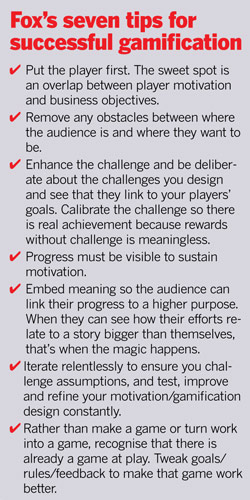Event planners are increasingly recognising the benefits of bringing out the element of fun in meetings and corporate activities through gamification. By S Puvaneswary
Gamification is the latest buzz-word in the business events industry and event organisers are paying attention to ways to best leverage this concept to keep their audiences engaged.
Gartner, Inc, a global information technology research and advisory company, describes gamification as “the use of game design and game mechanics to engage a target audience to change behaviors, learn new skills or engage in innovation”.
In an article published in November 2012, Gartner, Inc predicted that by 2014, 80 per cent of current gamified applications would fail to meet business objectives primarily because of poor design.
“The challenge facing project managers and sponsors responsible for gamification initiatives is the lack of game design talent… Poor game design is one of the key failings of many gamified applications today.” said Brian Burke, research vice president at the firm.
“The focus is on the obvious game mechanics, such as points, badges and leader boards, rather than the more subtle and important design elements, such as balancing competition and collaboration, or defining a meaningful game economy. As a result, in many cases, organisations are simply counting points, slapping meaningless badges on activities and creating gamified applications that are simply not engaging for the target audience,” he added.
“Gamification must be relevant to the clients’ business,” urged Nigel Gaunt, vice president global business at the headquarters of BI Worldwide. “For instance, I would use a game involving cars for clients in the automobile industry.”
Introducing the concept of gamification to Malaysian business event specialists at the Malaysia Convention and Exhibition Bureau’s Malaysia Business Events Week in August, Jason Fox, the author of The Game Changer and a motivation design expert, said meetings could be as engaging as online games if designed well and delegates would pay for good meeting experiences.
Mike van der Vijver, meeting designer of MindMeeting, which specialises in the design of effective programmes for international meetings, and co-author of Into the Heart of Meetings, suggested that debate – regarded as a form of gamification – can be used in events to engage the audience and develop solutions, especially for resolving conflicts.
Familiar with the use of debates in meetings, Eric Chuo, deputy general manager at AOS Conventions & Events, said such activities work well with young professionals and ROI can be measured when the audience votes for the winner through conference mobile apps.
According to Andrea Lee, area director – Kuala Lumpur at Destination Asia, the adoption of gamification in meetings is on the rise among her pharmaceutical clients. She said: “Many clients want us to design more than just a mundane meeting. They want inexpensive solutions to keep the audience attentive as pharmaceutical events tend to be very dry. We use games, especially after lunch as energy levels tend to be low, and the objectives are to entertain and educate the audience. We have used games to help the audience master the spelling of new drugs. Prizes are dangled to encourage participation.”
Gamification can also be used to motivate people towards aspirational goals.
Leon Qiu, client service director at BI Worldwide China, said online gamification is still very new in Asia, with countries receptive to this being China, South Korea and Singapore. He added that mobile and web based gamification is hot because it is fun and engaging for the player, and allows programme owners to easily track user generated data and behaviour.
Gaunt pointed out that gamification need not be a one-off activity. The qualifying period for some game-driven incentives can stretch up to a year, allowing participants to fulfil tasks and earn points towards their final score at the end of the period.
Kuala Lumpur Convention Centre has for some time now incorporated games into its internal meetings and training sessions to motivate and incentivise team members and to keep everyone attentive. An example of what the venue has done is The I-Maze, a hands-on game that challenges teams to discover a secret path to their goals through a series of mazes.
Rohizat Baharum, director of human resource at the venue, told TTGmice: “This problem-solving activity is great as it requires participants to work together and share specific information made available to them, in order to complete a task. It’s also excellent for team bonding as participants almost always begin in a state of confusion, followed by a major learning curve in effective planning, action and decision-making when they are forced to think out-of-the-box to complete the challenge. They also discover the value of common objectives and communication because the activity requires the full participation of all members.”
Sarawak Convention Bureau is also using games to motivate staff to win more event bids and meet more clients.
However, general manager Chew Chang Guan, warned that competition through gamification could make “players selfish and unwilling to share”.
“Thus we always emphasize on collaboration when we embark on such games,” said Chew.






















